Purple fungus Black & White Stock Photos
 textured background mushrooms close-up, macro photo with selective focus black and white photo Stock Photohttps://www.alamy.com/image-license-details/?v=1https://www.alamy.com/textured-background-mushrooms-close-up-macro-photo-with-selective-focus-black-and-white-photo-image491761637.html
textured background mushrooms close-up, macro photo with selective focus black and white photo Stock Photohttps://www.alamy.com/image-license-details/?v=1https://www.alamy.com/textured-background-mushrooms-close-up-macro-photo-with-selective-focus-black-and-white-photo-image491761637.htmlRF2KG1JYH–textured background mushrooms close-up, macro photo with selective focus black and white photo
 . Cyclopedia of American horticulture, comprising suggestions for cultivation of horticultural plants, descriptions of the species of fruits, vegetables, flowers, and ornamental plants sold in the United States and Canada, together with geographical and biographical sketches. Gardening. 724, Currant foliage attacked by the leaf-spot fungus (X J^). rium carpophilum). The most obscure disease of the peach is the "yellows," a name given to a contagious disorder that manifests itself in a premature ripening of thefruit, which takes on an unnatural spotting of red or purple, with the fles Stock Photohttps://www.alamy.com/image-license-details/?v=1https://www.alamy.com/cyclopedia-of-american-horticulture-comprising-suggestions-for-cultivation-of-horticultural-plants-descriptions-of-the-species-of-fruits-vegetables-flowers-and-ornamental-plants-sold-in-the-united-states-and-canada-together-with-geographical-and-biographical-sketches-gardening-724-currant-foliage-attacked-by-the-leaf-spot-fungus-x-j-rium-carpophilum-the-most-obscure-disease-of-the-peach-is-the-quotyellowsquot-a-name-given-to-a-contagious-disorder-that-manifests-itself-in-a-premature-ripening-of-thefruit-which-takes-on-an-unnatural-spotting-of-red-or-purple-with-the-fles-image216372560.html
. Cyclopedia of American horticulture, comprising suggestions for cultivation of horticultural plants, descriptions of the species of fruits, vegetables, flowers, and ornamental plants sold in the United States and Canada, together with geographical and biographical sketches. Gardening. 724, Currant foliage attacked by the leaf-spot fungus (X J^). rium carpophilum). The most obscure disease of the peach is the "yellows," a name given to a contagious disorder that manifests itself in a premature ripening of thefruit, which takes on an unnatural spotting of red or purple, with the fles Stock Photohttps://www.alamy.com/image-license-details/?v=1https://www.alamy.com/cyclopedia-of-american-horticulture-comprising-suggestions-for-cultivation-of-horticultural-plants-descriptions-of-the-species-of-fruits-vegetables-flowers-and-ornamental-plants-sold-in-the-united-states-and-canada-together-with-geographical-and-biographical-sketches-gardening-724-currant-foliage-attacked-by-the-leaf-spot-fungus-x-j-rium-carpophilum-the-most-obscure-disease-of-the-peach-is-the-quotyellowsquot-a-name-given-to-a-contagious-disorder-that-manifests-itself-in-a-premature-ripening-of-thefruit-which-takes-on-an-unnatural-spotting-of-red-or-purple-with-the-fles-image216372560.htmlRMPG0HBC–. Cyclopedia of American horticulture, comprising suggestions for cultivation of horticultural plants, descriptions of the species of fruits, vegetables, flowers, and ornamental plants sold in the United States and Canada, together with geographical and biographical sketches. Gardening. 724, Currant foliage attacked by the leaf-spot fungus (X J^). rium carpophilum). The most obscure disease of the peach is the "yellows," a name given to a contagious disorder that manifests itself in a premature ripening of thefruit, which takes on an unnatural spotting of red or purple, with the fles
 textured background of mushrooms purple lepista close-up black and white photo Stock Photohttps://www.alamy.com/image-license-details/?v=1https://www.alamy.com/textured-background-of-mushrooms-purple-lepista-close-up-black-and-white-photo-image569490230.html
textured background of mushrooms purple lepista close-up black and white photo Stock Photohttps://www.alamy.com/image-license-details/?v=1https://www.alamy.com/textured-background-of-mushrooms-purple-lepista-close-up-black-and-white-photo-image569490230.htmlRF2T2EEGP–textured background of mushrooms purple lepista close-up black and white photo
 . Insects injurious to fruits. Illustrated with four hundred and forty wood-cuts. Insect pests. 390 INSECTS INJURIOUS TO THE ORANGE. over both leaves and fruit, making them appear very unsightly. This is a minute fungous growth, known under the name of Fumago salicina Farlow, but it is believed by some to result from the punctures of insects, causing an exudation, on which the fungus thrives. As a remedy, use an alkaline solution of soap as strong as the tree will bear without injury. No. 250.—The Purple Scale. Mytilaspis citricola Packard. This is one of the most common and injurious species Stock Photohttps://www.alamy.com/image-license-details/?v=1https://www.alamy.com/insects-injurious-to-fruits-illustrated-with-four-hundred-and-forty-wood-cuts-insect-pests-390-insects-injurious-to-the-orange-over-both-leaves-and-fruit-making-them-appear-very-unsightly-this-is-a-minute-fungous-growth-known-under-the-name-of-fumago-salicina-farlow-but-it-is-believed-by-some-to-result-from-the-punctures-of-insects-causing-an-exudation-on-which-the-fungus-thrives-as-a-remedy-use-an-alkaline-solution-of-soap-as-strong-as-the-tree-will-bear-without-injury-no-250the-purple-scale-mytilaspis-citricola-packard-this-is-one-of-the-most-common-and-injurious-species-image231922576.html
. Insects injurious to fruits. Illustrated with four hundred and forty wood-cuts. Insect pests. 390 INSECTS INJURIOUS TO THE ORANGE. over both leaves and fruit, making them appear very unsightly. This is a minute fungous growth, known under the name of Fumago salicina Farlow, but it is believed by some to result from the punctures of insects, causing an exudation, on which the fungus thrives. As a remedy, use an alkaline solution of soap as strong as the tree will bear without injury. No. 250.—The Purple Scale. Mytilaspis citricola Packard. This is one of the most common and injurious species Stock Photohttps://www.alamy.com/image-license-details/?v=1https://www.alamy.com/insects-injurious-to-fruits-illustrated-with-four-hundred-and-forty-wood-cuts-insect-pests-390-insects-injurious-to-the-orange-over-both-leaves-and-fruit-making-them-appear-very-unsightly-this-is-a-minute-fungous-growth-known-under-the-name-of-fumago-salicina-farlow-but-it-is-believed-by-some-to-result-from-the-punctures-of-insects-causing-an-exudation-on-which-the-fungus-thrives-as-a-remedy-use-an-alkaline-solution-of-soap-as-strong-as-the-tree-will-bear-without-injury-no-250the-purple-scale-mytilaspis-citricola-packard-this-is-one-of-the-most-common-and-injurious-species-image231922576.htmlRMRD8YH4–. Insects injurious to fruits. Illustrated with four hundred and forty wood-cuts. Insect pests. 390 INSECTS INJURIOUS TO THE ORANGE. over both leaves and fruit, making them appear very unsightly. This is a minute fungous growth, known under the name of Fumago salicina Farlow, but it is believed by some to result from the punctures of insects, causing an exudation, on which the fungus thrives. As a remedy, use an alkaline solution of soap as strong as the tree will bear without injury. No. 250.—The Purple Scale. Mytilaspis citricola Packard. This is one of the most common and injurious species
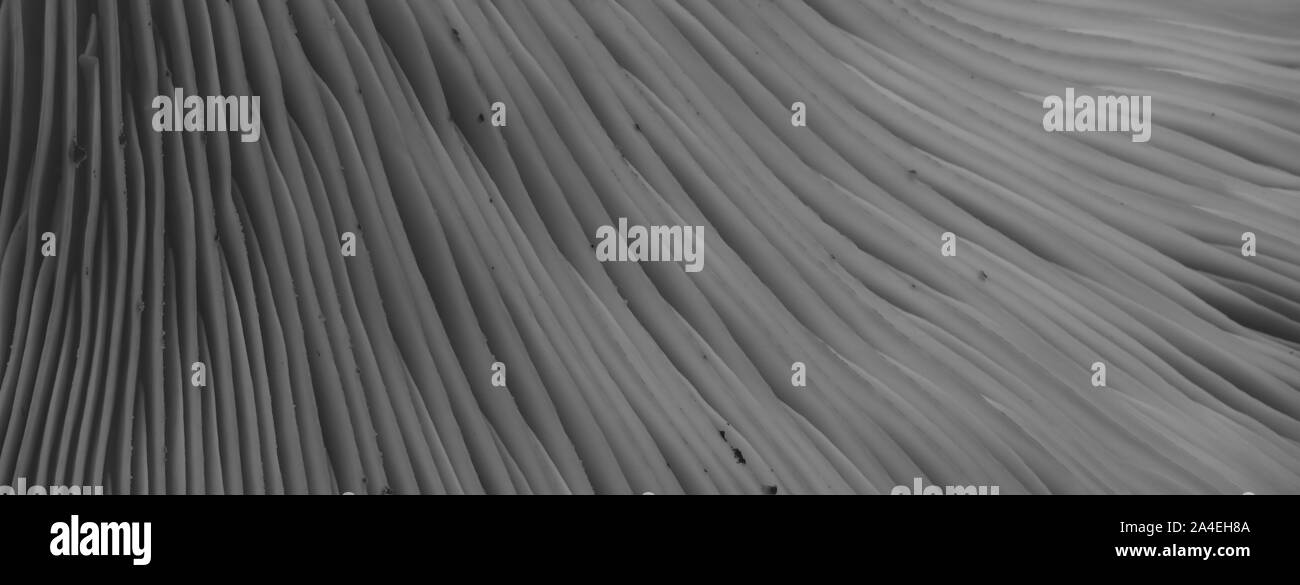 Close up beautiful mushrooms background texture. Stock Photohttps://www.alamy.com/image-license-details/?v=1https://www.alamy.com/close-up-beautiful-mushrooms-background-texture-image329776506.html
Close up beautiful mushrooms background texture. Stock Photohttps://www.alamy.com/image-license-details/?v=1https://www.alamy.com/close-up-beautiful-mushrooms-background-texture-image329776506.htmlRF2A4EH8A–Close up beautiful mushrooms background texture.
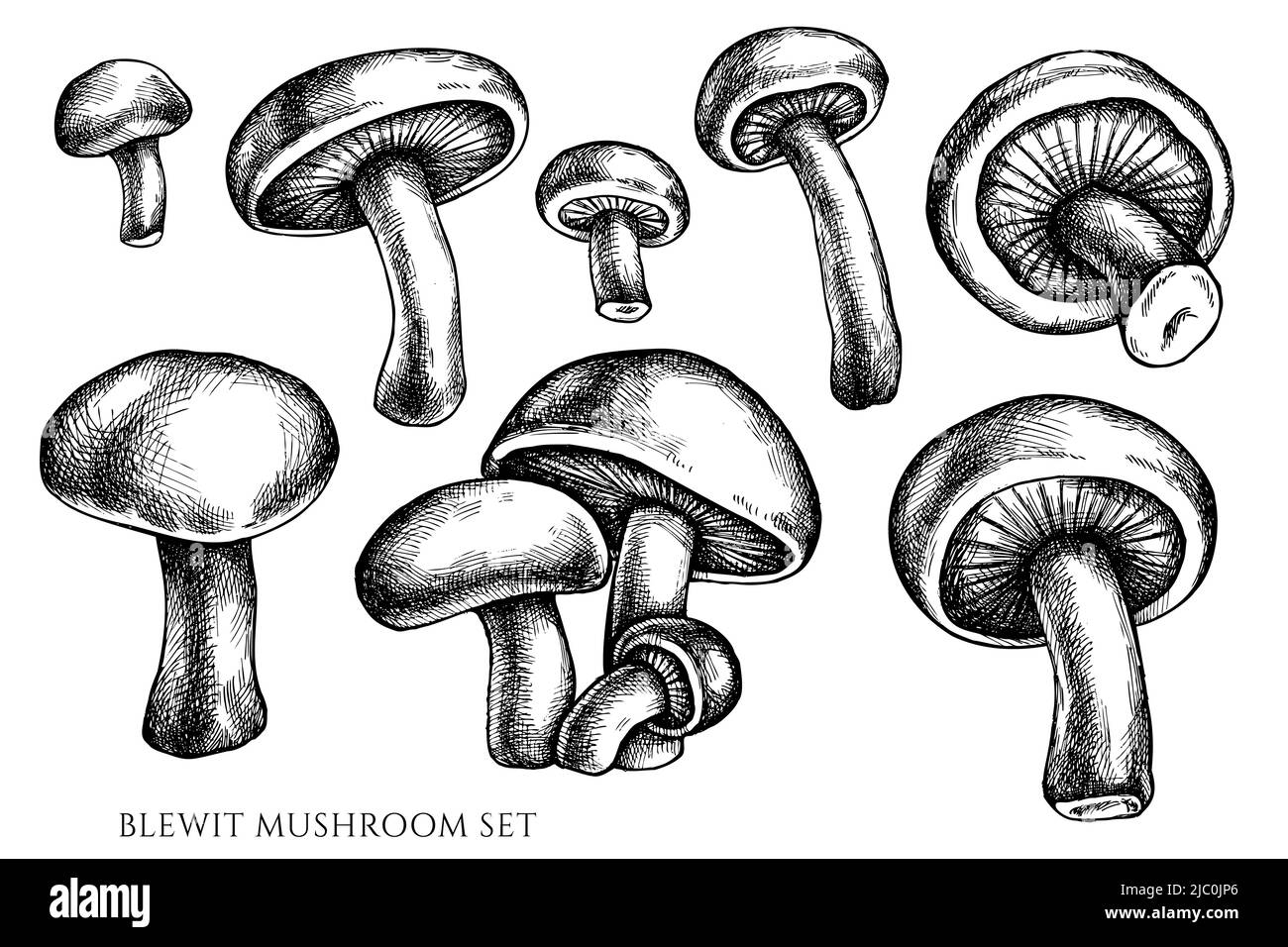 Vector set of hand drawn black and white blewit Stock Vectorhttps://www.alamy.com/image-license-details/?v=1https://www.alamy.com/vector-set-of-hand-drawn-black-and-white-blewit-image472070542.html
Vector set of hand drawn black and white blewit Stock Vectorhttps://www.alamy.com/image-license-details/?v=1https://www.alamy.com/vector-set-of-hand-drawn-black-and-white-blewit-image472070542.htmlRF2JC0JP6–Vector set of hand drawn black and white blewit
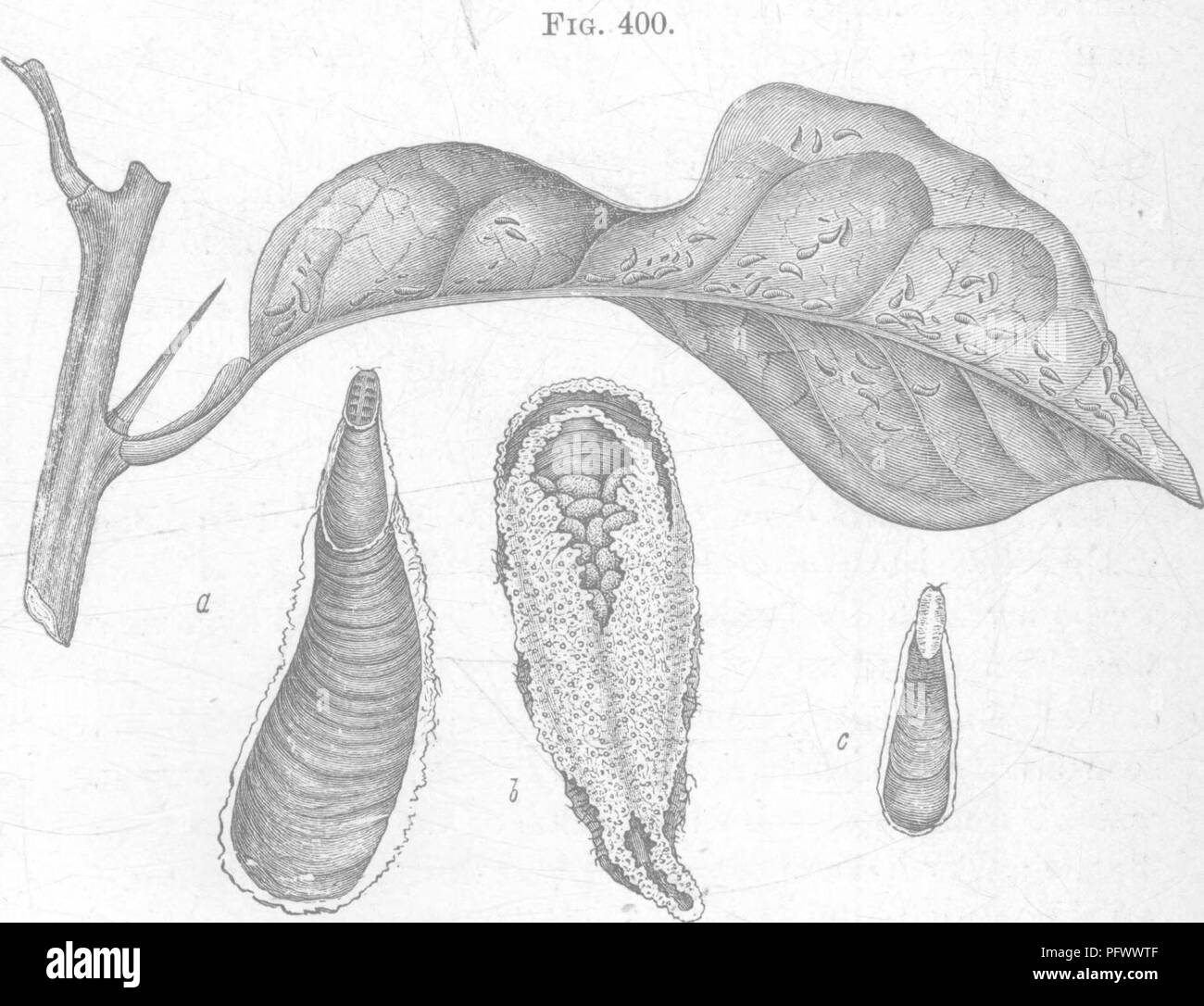 . Insects injurious to fruits. Illustrated with four hundred and forty wood-cuts. Insect pests. 390 INSECTS INJURIOUS TO THE ORANGE. over both leaves and fruit, making them appear very unsightly. This is a minute fungous growth, known under the name of Fumago salicina Farlow, but it is believed by some to result from the punctures of insects, causing an exudation, on which the fungus thrives. As a remedy, use an alkaline solution of soap as strong as the tree will bear without injury. No. 250.—The Purple Scale. Mytilaspis citricola Packard. This is one of the most common and injurious species Stock Photohttps://www.alamy.com/image-license-details/?v=1https://www.alamy.com/insects-injurious-to-fruits-illustrated-with-four-hundred-and-forty-wood-cuts-insect-pests-390-insects-injurious-to-the-orange-over-both-leaves-and-fruit-making-them-appear-very-unsightly-this-is-a-minute-fungous-growth-known-under-the-name-of-fumago-salicina-farlow-but-it-is-believed-by-some-to-result-from-the-punctures-of-insects-causing-an-exudation-on-which-the-fungus-thrives-as-a-remedy-use-an-alkaline-solution-of-soap-as-strong-as-the-tree-will-bear-without-injury-no-250the-purple-scale-mytilaspis-citricola-packard-this-is-one-of-the-most-common-and-injurious-species-image216313343.html
. Insects injurious to fruits. Illustrated with four hundred and forty wood-cuts. Insect pests. 390 INSECTS INJURIOUS TO THE ORANGE. over both leaves and fruit, making them appear very unsightly. This is a minute fungous growth, known under the name of Fumago salicina Farlow, but it is believed by some to result from the punctures of insects, causing an exudation, on which the fungus thrives. As a remedy, use an alkaline solution of soap as strong as the tree will bear without injury. No. 250.—The Purple Scale. Mytilaspis citricola Packard. This is one of the most common and injurious species Stock Photohttps://www.alamy.com/image-license-details/?v=1https://www.alamy.com/insects-injurious-to-fruits-illustrated-with-four-hundred-and-forty-wood-cuts-insect-pests-390-insects-injurious-to-the-orange-over-both-leaves-and-fruit-making-them-appear-very-unsightly-this-is-a-minute-fungous-growth-known-under-the-name-of-fumago-salicina-farlow-but-it-is-believed-by-some-to-result-from-the-punctures-of-insects-causing-an-exudation-on-which-the-fungus-thrives-as-a-remedy-use-an-alkaline-solution-of-soap-as-strong-as-the-tree-will-bear-without-injury-no-250the-purple-scale-mytilaspis-citricola-packard-this-is-one-of-the-most-common-and-injurious-species-image216313343.htmlRMPFWWTF–. Insects injurious to fruits. Illustrated with four hundred and forty wood-cuts. Insect pests. 390 INSECTS INJURIOUS TO THE ORANGE. over both leaves and fruit, making them appear very unsightly. This is a minute fungous growth, known under the name of Fumago salicina Farlow, but it is believed by some to result from the punctures of insects, causing an exudation, on which the fungus thrives. As a remedy, use an alkaline solution of soap as strong as the tree will bear without injury. No. 250.—The Purple Scale. Mytilaspis citricola Packard. This is one of the most common and injurious species
 background texture of mushrooms purple lepista close-up top view black and white photo Stock Photohttps://www.alamy.com/image-license-details/?v=1https://www.alamy.com/background-texture-of-mushrooms-purple-lepista-close-up-top-view-black-and-white-photo-image569490232.html
background texture of mushrooms purple lepista close-up top view black and white photo Stock Photohttps://www.alamy.com/image-license-details/?v=1https://www.alamy.com/background-texture-of-mushrooms-purple-lepista-close-up-top-view-black-and-white-photo-image569490232.htmlRF2T2EEGT–background texture of mushrooms purple lepista close-up top view black and white photo
 . Cyclopedia of American horticulture, comprising suggestions for cultivation of horticultural plants, descriptions of the species of fruits, vegetables, flowers, and ornamental plants sold in the United States and Canada, together with geographical and biographical sketches. Gardening. 724, Currant foliage attacked by the leaf-spot fungus (X J^). rium carpophilum). The most obscure disease of the peach is the "yellows," a name given to a contagious disorder that manifests itself in a premature ripening of thefruit, which takes on an unnatural spotting of red or purple, with the fles Stock Photohttps://www.alamy.com/image-license-details/?v=1https://www.alamy.com/cyclopedia-of-american-horticulture-comprising-suggestions-for-cultivation-of-horticultural-plants-descriptions-of-the-species-of-fruits-vegetables-flowers-and-ornamental-plants-sold-in-the-united-states-and-canada-together-with-geographical-and-biographical-sketches-gardening-724-currant-foliage-attacked-by-the-leaf-spot-fungus-x-j-rium-carpophilum-the-most-obscure-disease-of-the-peach-is-the-quotyellowsquot-a-name-given-to-a-contagious-disorder-that-manifests-itself-in-a-premature-ripening-of-thefruit-which-takes-on-an-unnatural-spotting-of-red-or-purple-with-the-fles-image231980642.html
. Cyclopedia of American horticulture, comprising suggestions for cultivation of horticultural plants, descriptions of the species of fruits, vegetables, flowers, and ornamental plants sold in the United States and Canada, together with geographical and biographical sketches. Gardening. 724, Currant foliage attacked by the leaf-spot fungus (X J^). rium carpophilum). The most obscure disease of the peach is the "yellows," a name given to a contagious disorder that manifests itself in a premature ripening of thefruit, which takes on an unnatural spotting of red or purple, with the fles Stock Photohttps://www.alamy.com/image-license-details/?v=1https://www.alamy.com/cyclopedia-of-american-horticulture-comprising-suggestions-for-cultivation-of-horticultural-plants-descriptions-of-the-species-of-fruits-vegetables-flowers-and-ornamental-plants-sold-in-the-united-states-and-canada-together-with-geographical-and-biographical-sketches-gardening-724-currant-foliage-attacked-by-the-leaf-spot-fungus-x-j-rium-carpophilum-the-most-obscure-disease-of-the-peach-is-the-quotyellowsquot-a-name-given-to-a-contagious-disorder-that-manifests-itself-in-a-premature-ripening-of-thefruit-which-takes-on-an-unnatural-spotting-of-red-or-purple-with-the-fles-image231980642.htmlRMRDBHJX–. Cyclopedia of American horticulture, comprising suggestions for cultivation of horticultural plants, descriptions of the species of fruits, vegetables, flowers, and ornamental plants sold in the United States and Canada, together with geographical and biographical sketches. Gardening. 724, Currant foliage attacked by the leaf-spot fungus (X J^). rium carpophilum). The most obscure disease of the peach is the "yellows," a name given to a contagious disorder that manifests itself in a premature ripening of thefruit, which takes on an unnatural spotting of red or purple, with the fles
 Seamless pattern with black and white blewit Stock Vectorhttps://www.alamy.com/image-license-details/?v=1https://www.alamy.com/seamless-pattern-with-black-and-white-blewit-image472153829.html
Seamless pattern with black and white blewit Stock Vectorhttps://www.alamy.com/image-license-details/?v=1https://www.alamy.com/seamless-pattern-with-black-and-white-blewit-image472153829.htmlRF2JC4D0N–Seamless pattern with black and white blewit
 . A manual of weeds : with descriptions of all the most pernicious and troublesome plants in the United States and Canada, their habits of growth and distribution, with methods of control . Weeds. POLYGONACEAE {BUCKWHEAT FAMILY) 101 fungus which turns the heads into a mass of purple spores, de- stroying the fruits so that "purplehead" is a benefit from the farmer's point of view. Achenes black, lens-shaped, smooth, and shining. (Fig. 59.) Means of control Cut closely or pull before any seeds have matured. Rankly infested ground should be put under cultivation before being again used Stock Photohttps://www.alamy.com/image-license-details/?v=1https://www.alamy.com/a-manual-of-weeds-with-descriptions-of-all-the-most-pernicious-and-troublesome-plants-in-the-united-states-and-canada-their-habits-of-growth-and-distribution-with-methods-of-control-weeds-polygonaceae-buckwheat-family-101-fungus-which-turns-the-heads-into-a-mass-of-purple-spores-de-stroying-the-fruits-so-that-quotpurpleheadquot-is-a-benefit-from-the-farmers-point-of-view-achenes-black-lens-shaped-smooth-and-shining-fig-59-means-of-control-cut-closely-or-pull-before-any-seeds-have-matured-rankly-infested-ground-should-be-put-under-cultivation-before-being-again-used-image216405653.html
. A manual of weeds : with descriptions of all the most pernicious and troublesome plants in the United States and Canada, their habits of growth and distribution, with methods of control . Weeds. POLYGONACEAE {BUCKWHEAT FAMILY) 101 fungus which turns the heads into a mass of purple spores, de- stroying the fruits so that "purplehead" is a benefit from the farmer's point of view. Achenes black, lens-shaped, smooth, and shining. (Fig. 59.) Means of control Cut closely or pull before any seeds have matured. Rankly infested ground should be put under cultivation before being again used Stock Photohttps://www.alamy.com/image-license-details/?v=1https://www.alamy.com/a-manual-of-weeds-with-descriptions-of-all-the-most-pernicious-and-troublesome-plants-in-the-united-states-and-canada-their-habits-of-growth-and-distribution-with-methods-of-control-weeds-polygonaceae-buckwheat-family-101-fungus-which-turns-the-heads-into-a-mass-of-purple-spores-de-stroying-the-fruits-so-that-quotpurpleheadquot-is-a-benefit-from-the-farmers-point-of-view-achenes-black-lens-shaped-smooth-and-shining-fig-59-means-of-control-cut-closely-or-pull-before-any-seeds-have-matured-rankly-infested-ground-should-be-put-under-cultivation-before-being-again-used-image216405653.htmlRMPG23H9–. A manual of weeds : with descriptions of all the most pernicious and troublesome plants in the United States and Canada, their habits of growth and distribution, with methods of control . Weeds. POLYGONACEAE {BUCKWHEAT FAMILY) 101 fungus which turns the heads into a mass of purple spores, de- stroying the fruits so that "purplehead" is a benefit from the farmer's point of view. Achenes black, lens-shaped, smooth, and shining. (Fig. 59.) Means of control Cut closely or pull before any seeds have matured. Rankly infested ground should be put under cultivation before being again used
 textured background of mushrooms close-up, focus black and white photo Stock Photohttps://www.alamy.com/image-license-details/?v=1https://www.alamy.com/textured-background-of-mushrooms-close-up-focus-black-and-white-photo-image559829715.html
textured background of mushrooms close-up, focus black and white photo Stock Photohttps://www.alamy.com/image-license-details/?v=1https://www.alamy.com/textured-background-of-mushrooms-close-up-focus-black-and-white-photo-image559829715.htmlRF2REPCEB–textured background of mushrooms close-up, focus black and white photo
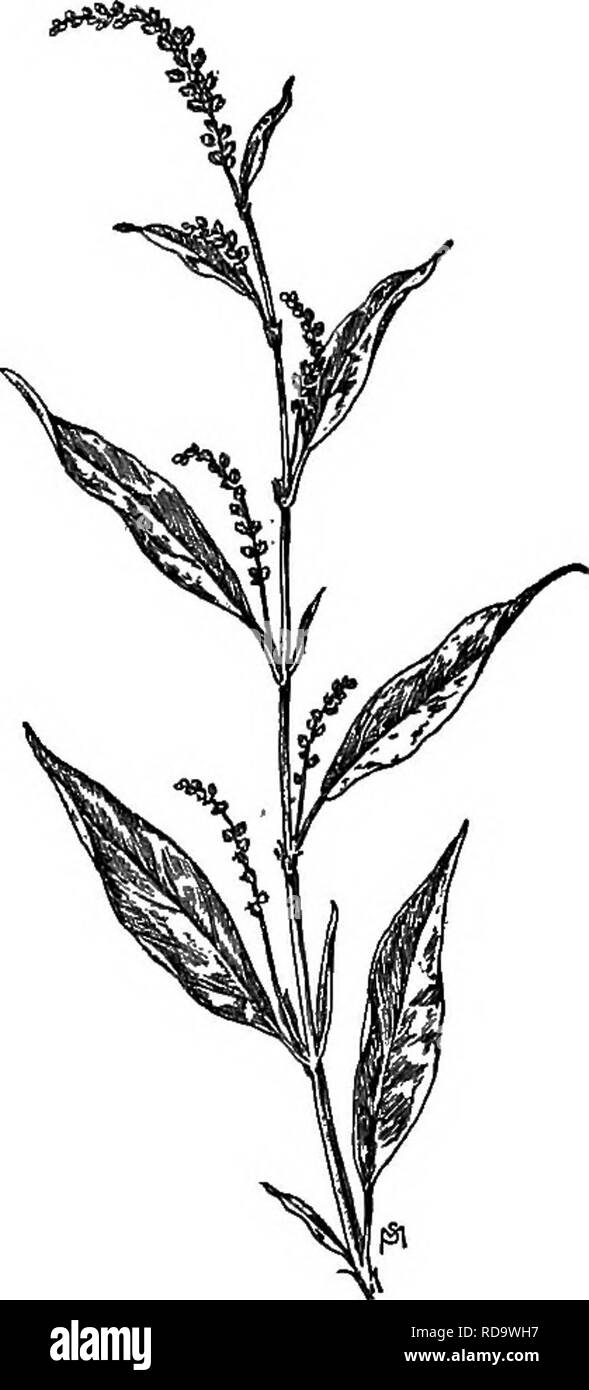 . A manual of weeds : with descriptions of all the most pernicious and troublesome plants in the United States and Canada, their habits of growth and distribution, with methods of control . Weeds. POLYGONACEAE {BUCKWHEAT FAMILY) 101 fungus which turns the heads into a mass of purple spores, de- stroying the fruits so that "purplehead" is a benefit from the farmer's point of view. Achenes black, lens-shaped, smooth, and shining. (Fig. 59.) Means of control Cut closely or pull before any seeds have matured. Rankly infested ground should be put under cultivation before being again used Stock Photohttps://www.alamy.com/image-license-details/?v=1https://www.alamy.com/a-manual-of-weeds-with-descriptions-of-all-the-most-pernicious-and-troublesome-plants-in-the-united-states-and-canada-their-habits-of-growth-and-distribution-with-methods-of-control-weeds-polygonaceae-buckwheat-family-101-fungus-which-turns-the-heads-into-a-mass-of-purple-spores-de-stroying-the-fruits-so-that-quotpurpleheadquot-is-a-benefit-from-the-farmers-point-of-view-achenes-black-lens-shaped-smooth-and-shining-fig-59-means-of-control-cut-closely-or-pull-before-any-seeds-have-matured-rankly-infested-ground-should-be-put-under-cultivation-before-being-again-used-image231942963.html
. A manual of weeds : with descriptions of all the most pernicious and troublesome plants in the United States and Canada, their habits of growth and distribution, with methods of control . Weeds. POLYGONACEAE {BUCKWHEAT FAMILY) 101 fungus which turns the heads into a mass of purple spores, de- stroying the fruits so that "purplehead" is a benefit from the farmer's point of view. Achenes black, lens-shaped, smooth, and shining. (Fig. 59.) Means of control Cut closely or pull before any seeds have matured. Rankly infested ground should be put under cultivation before being again used Stock Photohttps://www.alamy.com/image-license-details/?v=1https://www.alamy.com/a-manual-of-weeds-with-descriptions-of-all-the-most-pernicious-and-troublesome-plants-in-the-united-states-and-canada-their-habits-of-growth-and-distribution-with-methods-of-control-weeds-polygonaceae-buckwheat-family-101-fungus-which-turns-the-heads-into-a-mass-of-purple-spores-de-stroying-the-fruits-so-that-quotpurpleheadquot-is-a-benefit-from-the-farmers-point-of-view-achenes-black-lens-shaped-smooth-and-shining-fig-59-means-of-control-cut-closely-or-pull-before-any-seeds-have-matured-rankly-infested-ground-should-be-put-under-cultivation-before-being-again-used-image231942963.htmlRMRD9WH7–. A manual of weeds : with descriptions of all the most pernicious and troublesome plants in the United States and Canada, their habits of growth and distribution, with methods of control . Weeds. POLYGONACEAE {BUCKWHEAT FAMILY) 101 fungus which turns the heads into a mass of purple spores, de- stroying the fruits so that "purplehead" is a benefit from the farmer's point of view. Achenes black, lens-shaped, smooth, and shining. (Fig. 59.) Means of control Cut closely or pull before any seeds have matured. Rankly infested ground should be put under cultivation before being again used
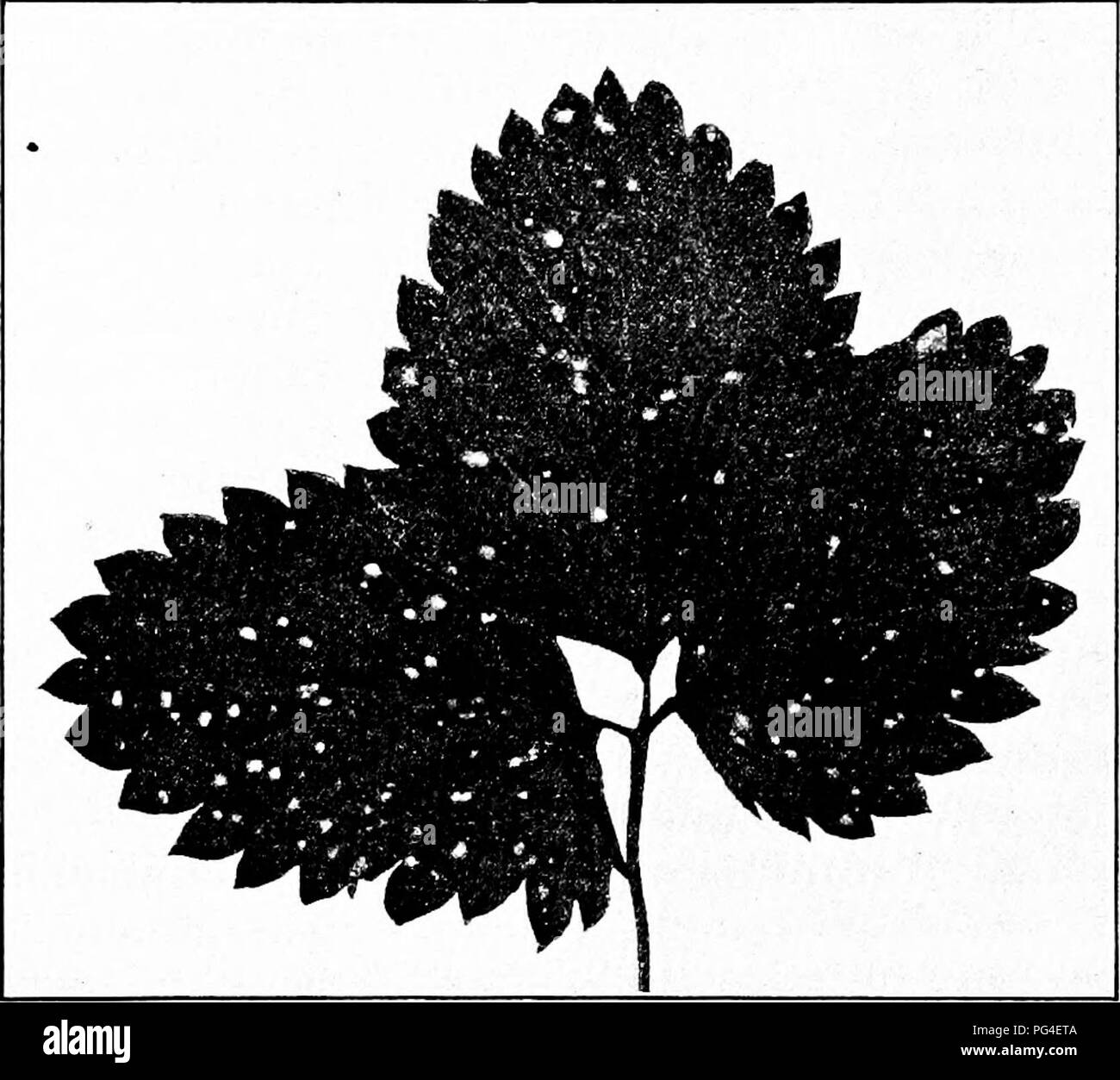 . Diseases of economic plants . Plant diseases. SMALL FRUITS 181 STRAWBERRY Leaf spot {Sphaerella fragarix (Tul.) Sacc). — The most conspicuous disease of the strawberry, one nearly al- ways present to some extent on both wild and culti-. FiG. 78. — Strawberry leaf spot. After Freeman. vated varieties, is known by the presence of small 4-6 mm. purple or red bordered spots upon the leaves, the older spots bearing white or ashen centers. Late in the development of the spots the hyphae of the causal fungus are barely visible in these centers with a good hand lens. The spots, when numerous, may co Stock Photohttps://www.alamy.com/image-license-details/?v=1https://www.alamy.com/diseases-of-economic-plants-plant-diseases-small-fruits-181-strawberry-leaf-spot-sphaerella-fragarix-tul-sacc-the-most-conspicuous-disease-of-the-strawberry-one-nearly-al-ways-present-to-some-extent-on-both-wild-and-culti-fig-78-strawberry-leaf-spot-after-freeman-vated-varieties-is-known-by-the-presence-of-small-4-6-mm-purple-or-red-bordered-spots-upon-the-leaves-the-older-spots-bearing-white-or-ashen-centers-late-in-the-development-of-the-spots-the-hyphae-of-the-causal-fungus-are-barely-visible-in-these-centers-with-a-good-hand-lens-the-spots-when-numerous-may-co-image216458378.html
. Diseases of economic plants . Plant diseases. SMALL FRUITS 181 STRAWBERRY Leaf spot {Sphaerella fragarix (Tul.) Sacc). — The most conspicuous disease of the strawberry, one nearly al- ways present to some extent on both wild and culti-. FiG. 78. — Strawberry leaf spot. After Freeman. vated varieties, is known by the presence of small 4-6 mm. purple or red bordered spots upon the leaves, the older spots bearing white or ashen centers. Late in the development of the spots the hyphae of the causal fungus are barely visible in these centers with a good hand lens. The spots, when numerous, may co Stock Photohttps://www.alamy.com/image-license-details/?v=1https://www.alamy.com/diseases-of-economic-plants-plant-diseases-small-fruits-181-strawberry-leaf-spot-sphaerella-fragarix-tul-sacc-the-most-conspicuous-disease-of-the-strawberry-one-nearly-al-ways-present-to-some-extent-on-both-wild-and-culti-fig-78-strawberry-leaf-spot-after-freeman-vated-varieties-is-known-by-the-presence-of-small-4-6-mm-purple-or-red-bordered-spots-upon-the-leaves-the-older-spots-bearing-white-or-ashen-centers-late-in-the-development-of-the-spots-the-hyphae-of-the-causal-fungus-are-barely-visible-in-these-centers-with-a-good-hand-lens-the-spots-when-numerous-may-co-image216458378.htmlRMPG4ETA–. Diseases of economic plants . Plant diseases. SMALL FRUITS 181 STRAWBERRY Leaf spot {Sphaerella fragarix (Tul.) Sacc). — The most conspicuous disease of the strawberry, one nearly al- ways present to some extent on both wild and culti-. FiG. 78. — Strawberry leaf spot. After Freeman. vated varieties, is known by the presence of small 4-6 mm. purple or red bordered spots upon the leaves, the older spots bearing white or ashen centers. Late in the development of the spots the hyphae of the causal fungus are barely visible in these centers with a good hand lens. The spots, when numerous, may co
 . Cirtus fruits under irragation. Citrus fruits; Fruit-culture. Fig. 20 Flonda red scale. The Hght-colored area around the Florida red scale m Fig. 21 illustrates the work of the pink fungus on this scale. Its method of application is the same as for the red- headed scale fungus. The insect enemies are about the same as those of the purple scale. In view of the fact that it is attacked by only a ew parasites, spraying must be largely resorted to. The miscible oils are the best insecticides but they do not kill either the eggs or the older scales efficiently. To do thorough § 28 CITRUS FRUITS I Stock Photohttps://www.alamy.com/image-license-details/?v=1https://www.alamy.com/cirtus-fruits-under-irragation-citrus-fruits-fruit-culture-fig-20-flonda-red-scale-the-hght-colored-area-around-the-florida-red-scale-m-fig-21-illustrates-the-work-of-the-pink-fungus-on-this-scale-its-method-of-application-is-the-same-as-for-the-red-headed-scale-fungus-the-insect-enemies-are-about-the-same-as-those-of-the-purple-scale-in-view-of-the-fact-that-it-is-attacked-by-only-a-ew-parasites-spraying-must-be-largely-resorted-to-the-miscible-oils-are-the-best-insecticides-but-they-do-not-kill-either-the-eggs-or-the-older-scales-efficiently-to-do-thorough-28-citrus-fruits-i-image232765544.html
. Cirtus fruits under irragation. Citrus fruits; Fruit-culture. Fig. 20 Flonda red scale. The Hght-colored area around the Florida red scale m Fig. 21 illustrates the work of the pink fungus on this scale. Its method of application is the same as for the red- headed scale fungus. The insect enemies are about the same as those of the purple scale. In view of the fact that it is attacked by only a ew parasites, spraying must be largely resorted to. The miscible oils are the best insecticides but they do not kill either the eggs or the older scales efficiently. To do thorough § 28 CITRUS FRUITS I Stock Photohttps://www.alamy.com/image-license-details/?v=1https://www.alamy.com/cirtus-fruits-under-irragation-citrus-fruits-fruit-culture-fig-20-flonda-red-scale-the-hght-colored-area-around-the-florida-red-scale-m-fig-21-illustrates-the-work-of-the-pink-fungus-on-this-scale-its-method-of-application-is-the-same-as-for-the-red-headed-scale-fungus-the-insect-enemies-are-about-the-same-as-those-of-the-purple-scale-in-view-of-the-fact-that-it-is-attacked-by-only-a-ew-parasites-spraying-must-be-largely-resorted-to-the-miscible-oils-are-the-best-insecticides-but-they-do-not-kill-either-the-eggs-or-the-older-scales-efficiently-to-do-thorough-28-citrus-fruits-i-image232765544.htmlRMREKAR4–. Cirtus fruits under irragation. Citrus fruits; Fruit-culture. Fig. 20 Flonda red scale. The Hght-colored area around the Florida red scale m Fig. 21 illustrates the work of the pink fungus on this scale. Its method of application is the same as for the red- headed scale fungus. The insect enemies are about the same as those of the purple scale. In view of the fact that it is attacked by only a ew parasites, spraying must be largely resorted to. The miscible oils are the best insecticides but they do not kill either the eggs or the older scales efficiently. To do thorough § 28 CITRUS FRUITS I
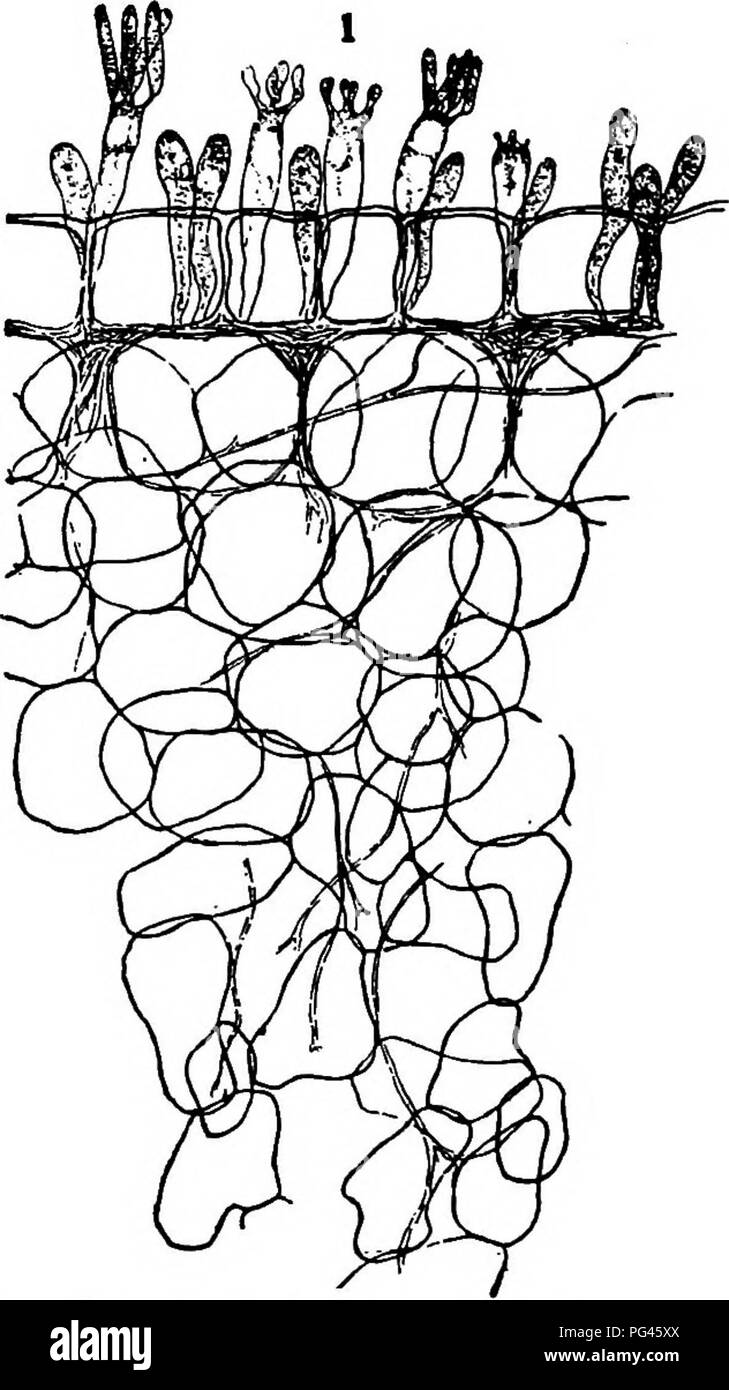 . The fungi which cause plant disease . Plant diseases; Fungi. THE FUNGI WHICH CAUSE PLANT DISEASE 397 EricacejE. Cultural work and studies in infection are needed be- fore species can be properly delimited.'' E. vaccinii (Fcl.) Wor. occurs on Vaccinium vitis idaea, forming large blisters on the leaves, rarely on petioles and stems, discoloration red or purple. The fungus appears as a white bloom on the under surface of the leaf; spores narrowly fusiform, 5-8 x 1-2 n. Richards ^ who studied E. vaccinii and E. an- dromedse from inoculations concludes: "Aside from the form of the distortion Stock Photohttps://www.alamy.com/image-license-details/?v=1https://www.alamy.com/the-fungi-which-cause-plant-disease-plant-diseases-fungi-the-fungi-which-cause-plant-disease-397-ericaceje-cultural-work-and-studies-in-infection-are-needed-be-fore-species-can-be-properly-delimited-e-vaccinii-fcl-wor-occurs-on-vaccinium-vitis-idaea-forming-large-blisters-on-the-leaves-rarely-on-petioles-and-stems-discoloration-red-or-purple-the-fungus-appears-as-a-white-bloom-on-the-under-surface-of-the-leaf-spores-narrowly-fusiform-5-8-x-1-2-n-richards-who-studied-e-vaccinii-and-e-an-dromedse-from-inoculations-concludes-quotaside-from-the-form-of-the-distortion-image216451394.html
. The fungi which cause plant disease . Plant diseases; Fungi. THE FUNGI WHICH CAUSE PLANT DISEASE 397 EricacejE. Cultural work and studies in infection are needed be- fore species can be properly delimited.'' E. vaccinii (Fcl.) Wor. occurs on Vaccinium vitis idaea, forming large blisters on the leaves, rarely on petioles and stems, discoloration red or purple. The fungus appears as a white bloom on the under surface of the leaf; spores narrowly fusiform, 5-8 x 1-2 n. Richards ^ who studied E. vaccinii and E. an- dromedse from inoculations concludes: "Aside from the form of the distortion Stock Photohttps://www.alamy.com/image-license-details/?v=1https://www.alamy.com/the-fungi-which-cause-plant-disease-plant-diseases-fungi-the-fungi-which-cause-plant-disease-397-ericaceje-cultural-work-and-studies-in-infection-are-needed-be-fore-species-can-be-properly-delimited-e-vaccinii-fcl-wor-occurs-on-vaccinium-vitis-idaea-forming-large-blisters-on-the-leaves-rarely-on-petioles-and-stems-discoloration-red-or-purple-the-fungus-appears-as-a-white-bloom-on-the-under-surface-of-the-leaf-spores-narrowly-fusiform-5-8-x-1-2-n-richards-who-studied-e-vaccinii-and-e-an-dromedse-from-inoculations-concludes-quotaside-from-the-form-of-the-distortion-image216451394.htmlRMPG45XX–. The fungi which cause plant disease . Plant diseases; Fungi. THE FUNGI WHICH CAUSE PLANT DISEASE 397 EricacejE. Cultural work and studies in infection are needed be- fore species can be properly delimited.'' E. vaccinii (Fcl.) Wor. occurs on Vaccinium vitis idaea, forming large blisters on the leaves, rarely on petioles and stems, discoloration red or purple. The fungus appears as a white bloom on the under surface of the leaf; spores narrowly fusiform, 5-8 x 1-2 n. Richards ^ who studied E. vaccinii and E. an- dromedse from inoculations concludes: "Aside from the form of the distortion
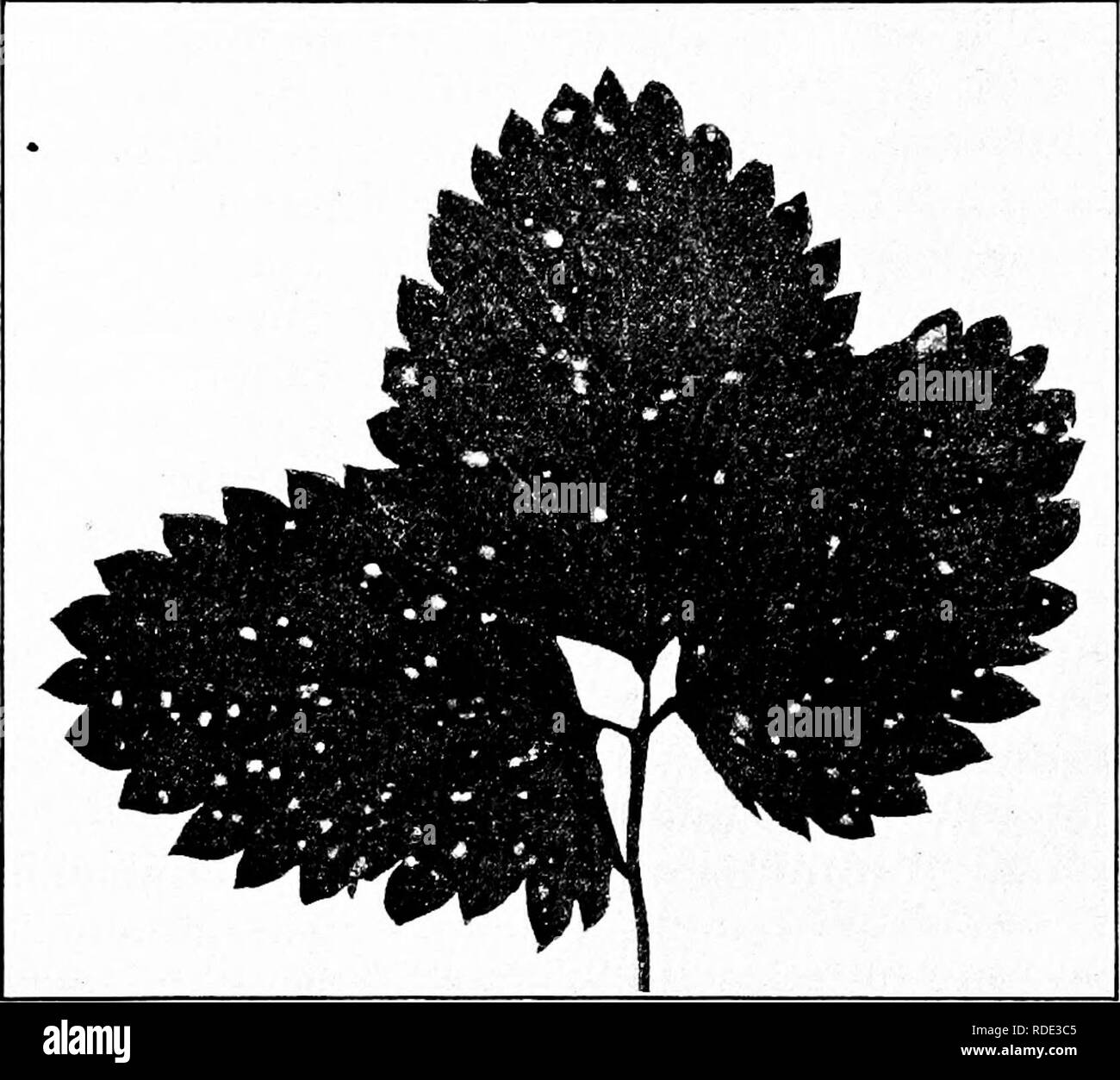 . Diseases of economic plants . Plant diseases. SMALL FRUITS 181 STRAWBERRY Leaf spot {Sphaerella fragarix (Tul.) Sacc). — The most conspicuous disease of the strawberry, one nearly al- ways present to some extent on both wild and culti-. FiG. 78. — Strawberry leaf spot. After Freeman. vated varieties, is known by the presence of small 4-6 mm. purple or red bordered spots upon the leaves, the older spots bearing white or ashen centers. Late in the development of the spots the hyphae of the causal fungus are barely visible in these centers with a good hand lens. The spots, when numerous, may co Stock Photohttps://www.alamy.com/image-license-details/?v=1https://www.alamy.com/diseases-of-economic-plants-plant-diseases-small-fruits-181-strawberry-leaf-spot-sphaerella-fragarix-tul-sacc-the-most-conspicuous-disease-of-the-strawberry-one-nearly-al-ways-present-to-some-extent-on-both-wild-and-culti-fig-78-strawberry-leaf-spot-after-freeman-vated-varieties-is-known-by-the-presence-of-small-4-6-mm-purple-or-red-bordered-spots-upon-the-leaves-the-older-spots-bearing-white-or-ashen-centers-late-in-the-development-of-the-spots-the-hyphae-of-the-causal-fungus-are-barely-visible-in-these-centers-with-a-good-hand-lens-the-spots-when-numerous-may-co-image232035333.html
. Diseases of economic plants . Plant diseases. SMALL FRUITS 181 STRAWBERRY Leaf spot {Sphaerella fragarix (Tul.) Sacc). — The most conspicuous disease of the strawberry, one nearly al- ways present to some extent on both wild and culti-. FiG. 78. — Strawberry leaf spot. After Freeman. vated varieties, is known by the presence of small 4-6 mm. purple or red bordered spots upon the leaves, the older spots bearing white or ashen centers. Late in the development of the spots the hyphae of the causal fungus are barely visible in these centers with a good hand lens. The spots, when numerous, may co Stock Photohttps://www.alamy.com/image-license-details/?v=1https://www.alamy.com/diseases-of-economic-plants-plant-diseases-small-fruits-181-strawberry-leaf-spot-sphaerella-fragarix-tul-sacc-the-most-conspicuous-disease-of-the-strawberry-one-nearly-al-ways-present-to-some-extent-on-both-wild-and-culti-fig-78-strawberry-leaf-spot-after-freeman-vated-varieties-is-known-by-the-presence-of-small-4-6-mm-purple-or-red-bordered-spots-upon-the-leaves-the-older-spots-bearing-white-or-ashen-centers-late-in-the-development-of-the-spots-the-hyphae-of-the-causal-fungus-are-barely-visible-in-these-centers-with-a-good-hand-lens-the-spots-when-numerous-may-co-image232035333.htmlRMRDE3C5–. Diseases of economic plants . Plant diseases. SMALL FRUITS 181 STRAWBERRY Leaf spot {Sphaerella fragarix (Tul.) Sacc). — The most conspicuous disease of the strawberry, one nearly al- ways present to some extent on both wild and culti-. FiG. 78. — Strawberry leaf spot. After Freeman. vated varieties, is known by the presence of small 4-6 mm. purple or red bordered spots upon the leaves, the older spots bearing white or ashen centers. Late in the development of the spots the hyphae of the causal fungus are barely visible in these centers with a good hand lens. The spots, when numerous, may co
 . British fungus-flora. A classified text-book of mycology. Fungi. HELVELLA. 465 In pine woods, among moss, &c. Specimen from. Fries examined. The present species lias by some authorities heen placed in the genus Peziza, used in the broader sense, on account of the concave or cup-shaped form of the young ascophore, but the entire structure is that of Hehella. Helvella atra. Konig, Zoega. Fl. Isl.. p. 20: Cke.. Mrcogr., fig. 167 ; Phil., Brit Disc, p. Hi; Sacc, Syll., viii. n. 81. Solitary, sooty-black or black with a purple shade; pileus droop- ing on opposite sides, depressed at the centr Stock Photohttps://www.alamy.com/image-license-details/?v=1https://www.alamy.com/british-fungus-flora-a-classified-text-book-of-mycology-fungi-helvella-465-in-pine-woods-among-moss-ampc-specimen-from-fries-examined-the-present-species-lias-by-some-authorities-heen-placed-in-the-genus-peziza-used-in-the-broader-sense-on-account-of-the-concave-or-cup-shaped-form-of-the-young-ascophore-but-the-entire-structure-is-that-of-hehella-helvella-atra-konig-zoega-fl-isl-p-20-cke-mrcogr-fig-167-phil-brit-disc-p-hi-sacc-syll-viii-n-81-solitary-sooty-black-or-black-with-a-purple-shade-pileus-droop-ing-on-opposite-sides-depressed-at-the-centr-image216438156.html
. British fungus-flora. A classified text-book of mycology. Fungi. HELVELLA. 465 In pine woods, among moss, &c. Specimen from. Fries examined. The present species lias by some authorities heen placed in the genus Peziza, used in the broader sense, on account of the concave or cup-shaped form of the young ascophore, but the entire structure is that of Hehella. Helvella atra. Konig, Zoega. Fl. Isl.. p. 20: Cke.. Mrcogr., fig. 167 ; Phil., Brit Disc, p. Hi; Sacc, Syll., viii. n. 81. Solitary, sooty-black or black with a purple shade; pileus droop- ing on opposite sides, depressed at the centr Stock Photohttps://www.alamy.com/image-license-details/?v=1https://www.alamy.com/british-fungus-flora-a-classified-text-book-of-mycology-fungi-helvella-465-in-pine-woods-among-moss-ampc-specimen-from-fries-examined-the-present-species-lias-by-some-authorities-heen-placed-in-the-genus-peziza-used-in-the-broader-sense-on-account-of-the-concave-or-cup-shaped-form-of-the-young-ascophore-but-the-entire-structure-is-that-of-hehella-helvella-atra-konig-zoega-fl-isl-p-20-cke-mrcogr-fig-167-phil-brit-disc-p-hi-sacc-syll-viii-n-81-solitary-sooty-black-or-black-with-a-purple-shade-pileus-droop-ing-on-opposite-sides-depressed-at-the-centr-image216438156.htmlRMPG3H24–. British fungus-flora. A classified text-book of mycology. Fungi. HELVELLA. 465 In pine woods, among moss, &c. Specimen from. Fries examined. The present species lias by some authorities heen placed in the genus Peziza, used in the broader sense, on account of the concave or cup-shaped form of the young ascophore, but the entire structure is that of Hehella. Helvella atra. Konig, Zoega. Fl. Isl.. p. 20: Cke.. Mrcogr., fig. 167 ; Phil., Brit Disc, p. Hi; Sacc, Syll., viii. n. 81. Solitary, sooty-black or black with a purple shade; pileus droop- ing on opposite sides, depressed at the centr
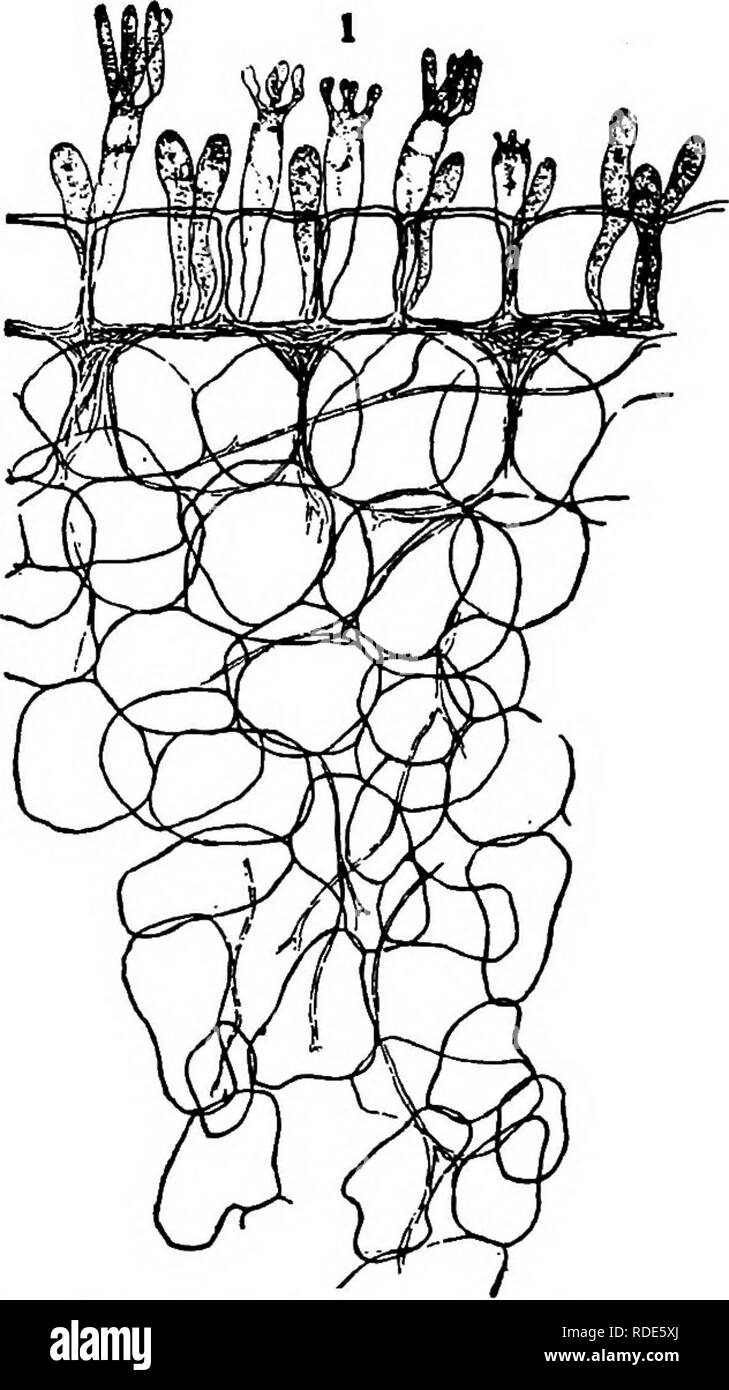 . The fungi which cause plant disease . Plant diseases; Fungi. THE FUNGI WHICH CAUSE PLANT DISEASE 397 EricacejE. Cultural work and studies in infection are needed be- fore species can be properly delimited.'' E. vaccinii (Fcl.) Wor. occurs on Vaccinium vitis idaea, forming large blisters on the leaves, rarely on petioles and stems, discoloration red or purple. The fungus appears as a white bloom on the under surface of the leaf; spores narrowly fusiform, 5-8 x 1-2 n. Richards ^ who studied E. vaccinii and E. an- dromedse from inoculations concludes: "Aside from the form of the distortion Stock Photohttps://www.alamy.com/image-license-details/?v=1https://www.alamy.com/the-fungi-which-cause-plant-disease-plant-diseases-fungi-the-fungi-which-cause-plant-disease-397-ericaceje-cultural-work-and-studies-in-infection-are-needed-be-fore-species-can-be-properly-delimited-e-vaccinii-fcl-wor-occurs-on-vaccinium-vitis-idaea-forming-large-blisters-on-the-leaves-rarely-on-petioles-and-stems-discoloration-red-or-purple-the-fungus-appears-as-a-white-bloom-on-the-under-surface-of-the-leaf-spores-narrowly-fusiform-5-8-x-1-2-n-richards-who-studied-e-vaccinii-and-e-an-dromedse-from-inoculations-concludes-quotaside-from-the-form-of-the-distortion-image232037306.html
. The fungi which cause plant disease . Plant diseases; Fungi. THE FUNGI WHICH CAUSE PLANT DISEASE 397 EricacejE. Cultural work and studies in infection are needed be- fore species can be properly delimited.'' E. vaccinii (Fcl.) Wor. occurs on Vaccinium vitis idaea, forming large blisters on the leaves, rarely on petioles and stems, discoloration red or purple. The fungus appears as a white bloom on the under surface of the leaf; spores narrowly fusiform, 5-8 x 1-2 n. Richards ^ who studied E. vaccinii and E. an- dromedse from inoculations concludes: "Aside from the form of the distortion Stock Photohttps://www.alamy.com/image-license-details/?v=1https://www.alamy.com/the-fungi-which-cause-plant-disease-plant-diseases-fungi-the-fungi-which-cause-plant-disease-397-ericaceje-cultural-work-and-studies-in-infection-are-needed-be-fore-species-can-be-properly-delimited-e-vaccinii-fcl-wor-occurs-on-vaccinium-vitis-idaea-forming-large-blisters-on-the-leaves-rarely-on-petioles-and-stems-discoloration-red-or-purple-the-fungus-appears-as-a-white-bloom-on-the-under-surface-of-the-leaf-spores-narrowly-fusiform-5-8-x-1-2-n-richards-who-studied-e-vaccinii-and-e-an-dromedse-from-inoculations-concludes-quotaside-from-the-form-of-the-distortion-image232037306.htmlRMRDE5XJ–. The fungi which cause plant disease . Plant diseases; Fungi. THE FUNGI WHICH CAUSE PLANT DISEASE 397 EricacejE. Cultural work and studies in infection are needed be- fore species can be properly delimited.'' E. vaccinii (Fcl.) Wor. occurs on Vaccinium vitis idaea, forming large blisters on the leaves, rarely on petioles and stems, discoloration red or purple. The fungus appears as a white bloom on the under surface of the leaf; spores narrowly fusiform, 5-8 x 1-2 n. Richards ^ who studied E. vaccinii and E. an- dromedse from inoculations concludes: "Aside from the form of the distortion
 . British fungus-flora. A classified text-book of mycology. Fungi. HELVELLA. 465 In pine woods, among moss, &c. Specimen from. Fries examined. The present species lias by some authorities heen placed in the genus Peziza, used in the broader sense, on account of the concave or cup-shaped form of the young ascophore, but the entire structure is that of Hehella. Helvella atra. Konig, Zoega. Fl. Isl.. p. 20: Cke.. Mrcogr., fig. 167 ; Phil., Brit Disc, p. Hi; Sacc, Syll., viii. n. 81. Solitary, sooty-black or black with a purple shade; pileus droop- ing on opposite sides, depressed at the centr Stock Photohttps://www.alamy.com/image-license-details/?v=1https://www.alamy.com/british-fungus-flora-a-classified-text-book-of-mycology-fungi-helvella-465-in-pine-woods-among-moss-ampc-specimen-from-fries-examined-the-present-species-lias-by-some-authorities-heen-placed-in-the-genus-peziza-used-in-the-broader-sense-on-account-of-the-concave-or-cup-shaped-form-of-the-young-ascophore-but-the-entire-structure-is-that-of-hehella-helvella-atra-konig-zoega-fl-isl-p-20-cke-mrcogr-fig-167-phil-brit-disc-p-hi-sacc-syll-viii-n-81-solitary-sooty-black-or-black-with-a-purple-shade-pileus-droop-ing-on-opposite-sides-depressed-at-the-centr-image232114957.html
. British fungus-flora. A classified text-book of mycology. Fungi. HELVELLA. 465 In pine woods, among moss, &c. Specimen from. Fries examined. The present species lias by some authorities heen placed in the genus Peziza, used in the broader sense, on account of the concave or cup-shaped form of the young ascophore, but the entire structure is that of Hehella. Helvella atra. Konig, Zoega. Fl. Isl.. p. 20: Cke.. Mrcogr., fig. 167 ; Phil., Brit Disc, p. Hi; Sacc, Syll., viii. n. 81. Solitary, sooty-black or black with a purple shade; pileus droop- ing on opposite sides, depressed at the centr Stock Photohttps://www.alamy.com/image-license-details/?v=1https://www.alamy.com/british-fungus-flora-a-classified-text-book-of-mycology-fungi-helvella-465-in-pine-woods-among-moss-ampc-specimen-from-fries-examined-the-present-species-lias-by-some-authorities-heen-placed-in-the-genus-peziza-used-in-the-broader-sense-on-account-of-the-concave-or-cup-shaped-form-of-the-young-ascophore-but-the-entire-structure-is-that-of-hehella-helvella-atra-konig-zoega-fl-isl-p-20-cke-mrcogr-fig-167-phil-brit-disc-p-hi-sacc-syll-viii-n-81-solitary-sooty-black-or-black-with-a-purple-shade-pileus-droop-ing-on-opposite-sides-depressed-at-the-centr-image232114957.htmlRMRDHMYW–. British fungus-flora. A classified text-book of mycology. Fungi. HELVELLA. 465 In pine woods, among moss, &c. Specimen from. Fries examined. The present species lias by some authorities heen placed in the genus Peziza, used in the broader sense, on account of the concave or cup-shaped form of the young ascophore, but the entire structure is that of Hehella. Helvella atra. Konig, Zoega. Fl. Isl.. p. 20: Cke.. Mrcogr., fig. 167 ; Phil., Brit Disc, p. Hi; Sacc, Syll., viii. n. 81. Solitary, sooty-black or black with a purple shade; pileus droop- ing on opposite sides, depressed at the centr
![. Florists' review [microform]. Floriculture. NDKR tli(> h.-a.liiii:.'- llnvV AiKithcr Mcn;ic(,'' in Tlic Kevicw for .l:tiiu;n 1"^, wliicli lins Just iciidiiMl irir licrc ;vt Kiirt'kn, orta- tion of all florists' jdants and nursery •, gipsy and brown tail moth, 'itrus white fly, black and purple scale, citrus canker, idicstnut fungus, hickory wireworm, white [)ine blis ter rust and many other pests from foreign lands, the losses already caused to this coun- try far excee<iing the total value of all the imports of iliints of every description during the last sixty years. Some Exampl Stock Photo . Florists' review [microform]. Floriculture. NDKR tli(> h.-a.liiii:.'- llnvV AiKithcr Mcn;ic(,'' in Tlic Kevicw for .l:tiiu;n 1"^, wliicli lins Just iciidiiMl irir licrc ;vt Kiirt'kn, orta- tion of all florists' jdants and nursery •, gipsy and brown tail moth, 'itrus white fly, black and purple scale, citrus canker, idicstnut fungus, hickory wireworm, white [)ine blis ter rust and many other pests from foreign lands, the losses already caused to this coun- try far excee<iing the total value of all the imports of iliints of every description during the last sixty years. Some Exampl Stock Photo](https://c8.alamy.com/comp/RRKY8E/florists-review-microform-floriculture-ndkr-tligt-h-aliiii-llnvv-aikithcr-mcnic-in-tlic-kevicw-for-ltiiun-1quot-wliicli-lins-just-iciidiiml-irir-licrc-vt-kiirtkn-orta-tion-of-all-florists-jdants-and-nursery-gipsy-and-brown-tail-moth-itrus-white-fly-black-and-purple-scale-citrus-canker-idicstnut-fungus-hickory-wireworm-white-ine-blis-ter-rust-and-many-other-pests-from-foreign-lands-the-losses-already-caused-to-this-coun-try-far-exceeltiing-the-total-value-of-all-the-imports-of-iliints-of-every-description-during-the-last-sixty-years-some-exampl-RRKY8E.jpg) . Florists' review [microform]. Floriculture. NDKR tli(> h.-a.liiii:.'- llnvV AiKithcr Mcn;ic(,'' in Tlic Kevicw for .l:tiiu;n 1"^, wliicli lins Just iciidiiMl irir licrc ;vt Kiirt'kn, orta- tion of all florists' jdants and nursery •, gipsy and brown tail moth, 'itrus white fly, black and purple scale, citrus canker, idicstnut fungus, hickory wireworm, white [)ine blis ter rust and many other pests from foreign lands, the losses already caused to this coun- try far excee<iing the total value of all the imports of iliints of every description during the last sixty years. Some Exampl Stock Photohttps://www.alamy.com/image-license-details/?v=1https://www.alamy.com/florists-review-microform-floriculture-ndkr-tligt-h-aliiii-llnvv-aikithcr-mcnic-in-tlic-kevicw-for-ltiiun-1quot-wliicli-lins-just-iciidiiml-irir-licrc-vt-kiirtkn-orta-tion-of-all-florists-jdants-and-nursery-gipsy-and-brown-tail-moth-itrus-white-fly-black-and-purple-scale-citrus-canker-idicstnut-fungus-hickory-wireworm-white-ine-blis-ter-rust-and-many-other-pests-from-foreign-lands-the-losses-already-caused-to-this-coun-try-far-exceeltiing-the-total-value-of-all-the-imports-of-iliints-of-every-description-during-the-last-sixty-years-some-exampl-image238310366.html
. Florists' review [microform]. Floriculture. NDKR tli(> h.-a.liiii:.'- llnvV AiKithcr Mcn;ic(,'' in Tlic Kevicw for .l:tiiu;n 1"^, wliicli lins Just iciidiiMl irir licrc ;vt Kiirt'kn, orta- tion of all florists' jdants and nursery •, gipsy and brown tail moth, 'itrus white fly, black and purple scale, citrus canker, idicstnut fungus, hickory wireworm, white [)ine blis ter rust and many other pests from foreign lands, the losses already caused to this coun- try far excee<iing the total value of all the imports of iliints of every description during the last sixty years. Some Exampl Stock Photohttps://www.alamy.com/image-license-details/?v=1https://www.alamy.com/florists-review-microform-floriculture-ndkr-tligt-h-aliiii-llnvv-aikithcr-mcnic-in-tlic-kevicw-for-ltiiun-1quot-wliicli-lins-just-iciidiiml-irir-licrc-vt-kiirtkn-orta-tion-of-all-florists-jdants-and-nursery-gipsy-and-brown-tail-moth-itrus-white-fly-black-and-purple-scale-citrus-canker-idicstnut-fungus-hickory-wireworm-white-ine-blis-ter-rust-and-many-other-pests-from-foreign-lands-the-losses-already-caused-to-this-coun-try-far-exceeltiing-the-total-value-of-all-the-imports-of-iliints-of-every-description-during-the-last-sixty-years-some-exampl-image238310366.htmlRMRRKY8E–. Florists' review [microform]. Floriculture. NDKR tli(> h.-a.liiii:.'- llnvV AiKithcr Mcn;ic(,'' in Tlic Kevicw for .l:tiiu;n 1"^, wliicli lins Just iciidiiMl irir licrc ;vt Kiirt'kn, orta- tion of all florists' jdants and nursery •, gipsy and brown tail moth, 'itrus white fly, black and purple scale, citrus canker, idicstnut fungus, hickory wireworm, white [)ine blis ter rust and many other pests from foreign lands, the losses already caused to this coun- try far excee<iing the total value of all the imports of iliints of every description during the last sixty years. Some Exampl
RMRPY121–. Hawaiian Fungi. Fungi. Stevens—Hawaiian Fungi 159 PHAEOSTILBEAE-AMEROSPORAK 154. GRAPHIUM Corda. Icones fung. vol. 1, p. 18, 1837 No. 377. Graphium dubautiae Stevens and Weedon n. sp. Spots viewed from above are with white centers 1-2 m.. in diameter, surrounded by a broad, 2-3 mm., dark purple border. Spots from below are tan-colored. Fungus hypophyllous. Synemata few on each spot, sterile, basal portion either short (60 m), or long (310 m), by 20 M thick. Base dark, shading to nearly hyaline at the top. Synema separating toward the upper third of its length into the component filaments, wh
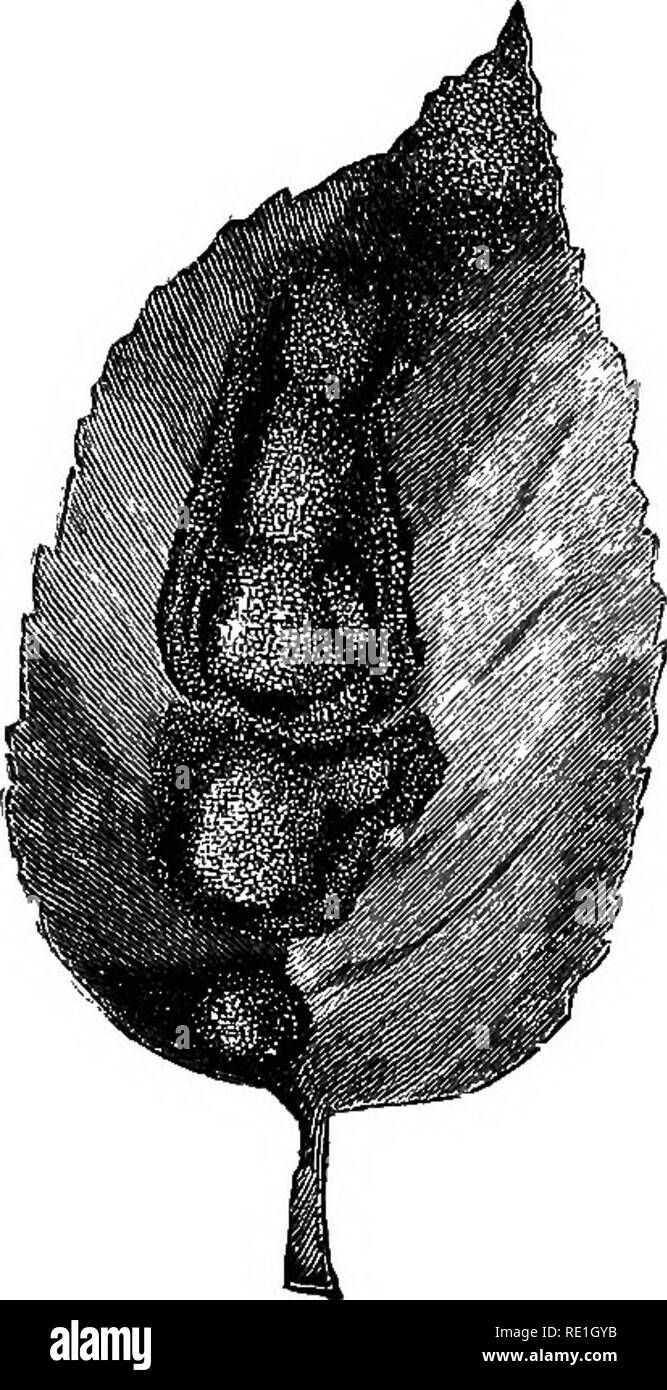 . Fungi and fungicides. Fungi; Fungicides. FUNGI AND FUNGICIDES. ANTHRACNOSE. Affecting the Raspberry, Blackberry, and Rose. This fungus appears as small reddish-purple spots upon the canes and leaves in the spring and early summer. These spots- are scattered over the surface of the new growth near the ground, and have a distinct purplish margin, representing the. Fig. 7. Rose leaf black spot.. Please note that these images are extracted from scanned page images that may have been digitally enhanced for readability - coloration and appearance of these illustrations may not perfectly resemble t Stock Photohttps://www.alamy.com/image-license-details/?v=1https://www.alamy.com/fungi-and-fungicides-fungi-fungicides-fungi-and-fungicides-anthracnose-affecting-the-raspberry-blackberry-and-rose-this-fungus-appears-as-small-reddish-purple-spots-upon-the-canes-and-leaves-in-the-spring-and-early-summer-these-spots-are-scattered-over-the-surface-of-the-new-growth-near-the-ground-and-have-a-distinct-purplish-margin-representing-the-fig-7-rose-leaf-black-spot-please-note-that-these-images-are-extracted-from-scanned-page-images-that-may-have-been-digitally-enhanced-for-readability-coloration-and-appearance-of-these-illustrations-may-not-perfectly-resemble-t-image232375231.html
. Fungi and fungicides. Fungi; Fungicides. FUNGI AND FUNGICIDES. ANTHRACNOSE. Affecting the Raspberry, Blackberry, and Rose. This fungus appears as small reddish-purple spots upon the canes and leaves in the spring and early summer. These spots- are scattered over the surface of the new growth near the ground, and have a distinct purplish margin, representing the. Fig. 7. Rose leaf black spot.. Please note that these images are extracted from scanned page images that may have been digitally enhanced for readability - coloration and appearance of these illustrations may not perfectly resemble t Stock Photohttps://www.alamy.com/image-license-details/?v=1https://www.alamy.com/fungi-and-fungicides-fungi-fungicides-fungi-and-fungicides-anthracnose-affecting-the-raspberry-blackberry-and-rose-this-fungus-appears-as-small-reddish-purple-spots-upon-the-canes-and-leaves-in-the-spring-and-early-summer-these-spots-are-scattered-over-the-surface-of-the-new-growth-near-the-ground-and-have-a-distinct-purplish-margin-representing-the-fig-7-rose-leaf-black-spot-please-note-that-these-images-are-extracted-from-scanned-page-images-that-may-have-been-digitally-enhanced-for-readability-coloration-and-appearance-of-these-illustrations-may-not-perfectly-resemble-t-image232375231.htmlRMRE1GYB–. Fungi and fungicides. Fungi; Fungicides. FUNGI AND FUNGICIDES. ANTHRACNOSE. Affecting the Raspberry, Blackberry, and Rose. This fungus appears as small reddish-purple spots upon the canes and leaves in the spring and early summer. These spots- are scattered over the surface of the new growth near the ground, and have a distinct purplish margin, representing the. Fig. 7. Rose leaf black spot.. Please note that these images are extracted from scanned page images that may have been digitally enhanced for readability - coloration and appearance of these illustrations may not perfectly resemble t